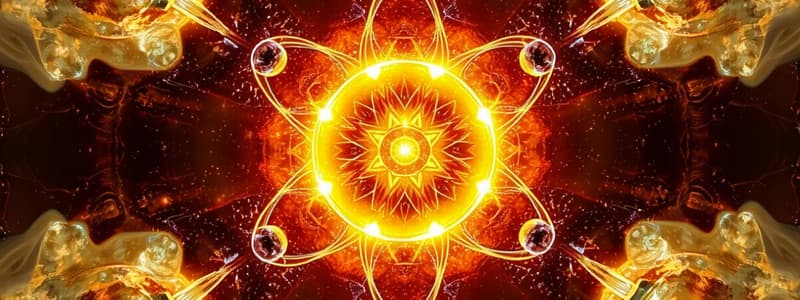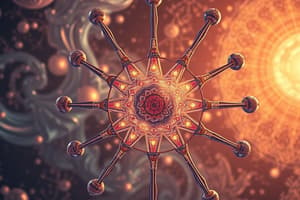Podcast
Questions and Answers
What defines the atomic number of an element?
What defines the atomic number of an element?
- The number of electrons surrounding the nucleus
- The number of protons in the nucleus (correct)
- The number of neutrons in the nucleus
- The total number of protons and neutrons
What do isotopes of the same element have in common?
What do isotopes of the same element have in common?
- They have the same mass number
- They have the same number of neutrons
- They have the same number of protons and electrons (correct)
- They have different numbers of protons
What is the main function of mass spectrometry?
What is the main function of mass spectrometry?
- To measure the temperature of substances
- To determine the exact physical location of atoms
- To provide information on relative isotopic mass and abundance (correct)
- To analyze the electron configuration of atoms
What is the relative mass of an electron compared to a proton?
What is the relative mass of an electron compared to a proton?
Which statement accurately describes neutrons?
Which statement accurately describes neutrons?
Flashcards are hidden until you start studying
Study Notes
Atomic Structure Fundamentals
- Atomic Number: Represents the number of protons in an atom's nucleus, determining the element's identity.
- Bohr Model: Describes the atom as having a dense nucleus surrounded by electrons in defined orbits, helping to explain atomic properties and behaviors.
- Electron: A subatomic particle with a negative charge, orbiting the nucleus at various energy levels; relative mass is 1/1836 of a proton.
- Ion: Refers to an atom or molecule that has gained or lost electrons, resulting in a charged state.
Isotopes and Their Properties
- Isotopes: Variants of a chemical element that have the same number of protons and electrons but differing numbers of neutrons, leading to different atomic masses.
- Mass Number: The sum of protons and neutrons in an atomic nucleus, indicating the total number of these particles.
Instrumentation and Measurement
- Mass Spectrometry: A technique used to derive precise details on isotopic mass and the relative abundance of each isotope within a sample.
- Neutron: A subatomic particle with no charge, located in the nucleus with a relative mass of 1.
- Proton: A positively charged subatomic particle also found in the nucleus, possessing a relative mass of 1.
Mass Measurement Concepts
- Relative Abundance: Metric assessing the quantity of one substance in relation to another, often used in isotopic studies.
- Relative Atomic Mass: The average mass of an atom of an element, calculated relative to 1/12th the mass of a carbon-12 atom.
- Relative Isotopic Mass: Represents the mass of an individual isotope against 1/12th the mass of a carbon-12 atom.
- Relative Formula Mass: The mass of a compound's formula unit, particularly in giant structures, such as the NaCl with a relative formula mass of 58.44 g/mol.
- Relative Molecular Mass (Mr): The mass of a discrete molecule, often used in molecular chemistry.
Studying That Suits You
Use AI to generate personalized quizzes and flashcards to suit your learning preferences.




